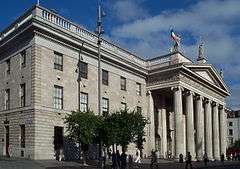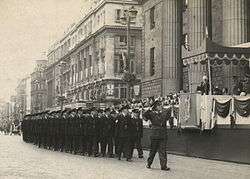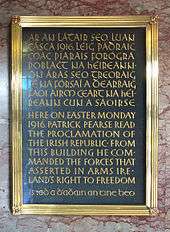General Post Office, Dublin
| General Post Office | |
|---|---|
| Ard-Oifig an Phoist | |
 The General Post Office in 2006 | |
 Location of the General Post Office in central Dublin | |
| General information | |
| Type | Post office and administrative offices |
| Architectural style | Greek Revival, neoclassical |
| Location | O'Connell Street, Dublin 1 |
| Coordinates | 53°20′58″N 6°15′40″W / 53.349334°N 6.261075°W |
| Construction started | 12 August 1814 |
| Inaugurated | 6 January 1818 |
| Cost | £50,000 pounds sterling |
| Owner | Office of public works |
| Design and construction | |
| Architect | Francis Johnston |
The General Post Office (GPO; Irish: Ard-Oifig an Phoist) in Dublin is the headquarters of the Irish Post Office, An Post, and Dublin's principal post office. Sited in the centre of O'Connell Street, the city's main thoroughfare, it is one of Ireland's most famous buildings, and was the last of the great Georgian public buildings erected in the capital.
Architecture
The GPO was first located in a small building on the site of where the Commercial Buildings used to be (now the Central Bank building) off Dame Street, and was afterwards removed to a larger house opposite the Bank of Ireland building on College Green. On 6 January 1818, the new post-office in Sackville Street (now O'Connell Street) was opened for business. The foundation-stone of the building, which is built after a design of Francis Johnston, was laid by the Lord Lieutenant of Ireland, Charles Whitworth, 1st Earl Whitworth, on 12 August 1814, attended by the Post-Masters-General, Charles O'Neill, 1st Earl O'Neill and Laurence Parsons, 2nd Earl of Rosse.[1][2] The structure was completed in the short space of three years for the sum of £50,000.

The front, which extends 67.1 metres (220 ft), has an Ionic portico (24.4 metres (80 ft) wide), of six fluted Ionic columns, 137.16 centimetres (54 inches) in diameter. The frieze of the entablature is highly enriched, and in the tympanum of the pediment were the royal arms until removed following restoration in the 1920s. On the acroteria of the pediment are three statues by John Smyth: when facing the building Mercury on the left, with his Caduceus and purse; Fidelity on the right, with a hound at her feet and a key held in her right hand (due to these features it is argued that the statue is in fact of Hecate); and Hibernia in the centre, resting on her spear and holding a harp. The entablature, with the exception of the architrave, is continued along the rest of the front; the frieze, however, is not decorated over the portico. A balustrade surmounts the cornice of the building, which is 15.2 metres (50 ft) from the ground.
With the exception of the portico, which is of Portland stone, the whole is of mountain granite. The elevation has three stories, of which the lower or basement is rusticated, and in this respect it resembles the India House of London, where a rusticated basement is introduced, although the portico occupies the entire height of the structure.
History

During the Easter Rising of 1916, the GPO served as the headquarters of the uprising's leaders. The building was destroyed by fire in the course of the rebellion and not repaired until the Irish Free State government took up the task some years later. The facade is all that remains of the original building. An original copy of the Proclamation of the Irish Republic was on display in the An Post museum at the GPO, where an exhibition, Letters, Lives & Liberty, highlighted the history of the Post Office and the GPO. The museum closed at the end of May 2015 being replaced by a new visitor centre to commemorate the 1916 Rising, 'GPO Witness History', in March 2016. The building has remained a symbol of Irish nationalism. In commemoration of the Rising, a statue depicting the death of the mythical hero Cúchulainn sculpted by Oliver Sheppard in 1911 was sited at the command post in the centre of the GPO main hall and is now housed in the front of the building. The statue was featured on the Irish ten shilling coin of 1966, marking the fiftieth anniversary of the Rising. Despite its fame as an iconic place of Irish freedom, ground rent for the GPO continued to be paid to English and American landlords until the 1980s.[3]
The broadcasting studios of 2RN, which later became Radio Éireann, were located at the GPO from 1928 until 1974.[4] Draws for Prize Bonds are held weekly, on Fridays, in the building.
Nelson's Pillar was formerly located in the centre of O'Connell Street adjacent to the GPO. However the Pillar was destroyed by Irish republicans in an explosion in 1966. The Spire of Dublin now takes a dominant position on the site of the Pillar.
Images
 The General Post Office in 2006
The General Post Office in 2006 The General Post Office c.1830
The General Post Office c.1830_p095_POST_OFFICE.jpg) The GPO in an engraving from about 1831
The GPO in an engraving from about 1831- Before independence with British flag flying. The adjacent Hotel Metropole was destroyed in 1916.

 A plaque commemorating the Easter Rising at the GPO
A plaque commemorating the Easter Rising at the GPO 1964 view from Nelson's Pillar prior to the pillar's destruction
1964 view from Nelson's Pillar prior to the pillar's destruction
References
- ↑ Haydn, Joseph (1851). The Book of Dignities. London: Longmans, Brown, Green and Longmans. p. 461.
- ↑ M'Gregor, John James (1821). Picture of Dublin. Dublin: C. P. Archer. p. 40.
- ↑ Debate on GPO ground rent
- ↑ Sexton, Michael (2005). Marconi: the Irish connection. Four Courts Press. p. 104. ISBN 1-85182-841-9.
External links
| Wikimedia Commons has media related to General Post Office (Dublin). |
- Irish Architecture Online: GPO history and pictures
- Project Gutenberg Article
- An Post History and Heritage – The GPO
- The 1916 Rising by Norman Teeling a ten-painting suite highlighting historical moments of the Easter Rising acquired by An Post for permanent display at the GPO
- The Dublin Penny Journal, 6 December 1834.
Coordinates: 53°20′58″N 6°15′40″W / 53.349334°N 6.261075°W